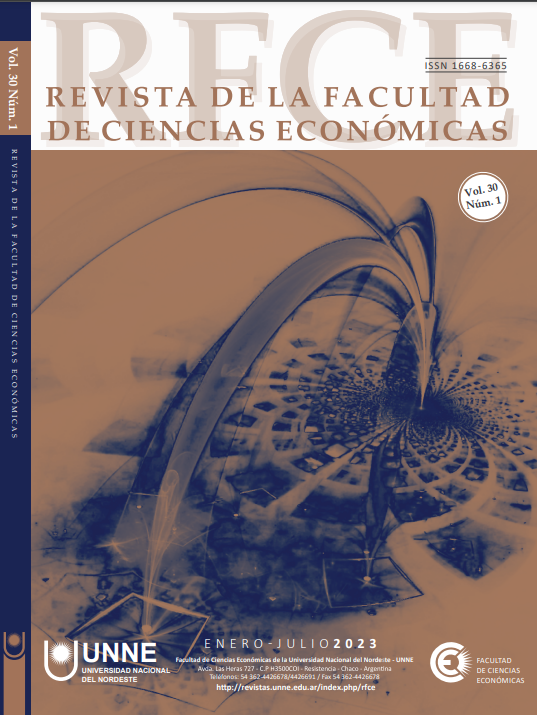Higher education in Argentina. Impact on the labor market and territorial asymmetries
DOI:
https://doi.org/10.30972/rfce.3016711Keywords:
Inequality, Higher education, Labor market, Scholarship, Regional asymmetriesAbstract
This paper addresses the incidence of higher education in the Argentine labor market, and the recent evolution in access to this system considering asymmetries at the regional level. To do this, firstly, the main approaches that, from economics and sociology, have contributed to explain the reproduction of social and educational inequalities are examined. It then describes how access to higher levels of education has a positive impact on the quality of labor insertion, and reviews the recent evolution of access to the Argentine higher education system. Likewise, some responses are valued that from public policy contribute to making access to this educational level effective and reducing desertion, among which the economic support scholarship policies stand out.
References
Abeles, M. y Villafañe, S. (coords.). (2022). Asimetrías y desigualdades territoriales en la Argentina: aportes para el debate (LC/TS.2022/146-LC/BUE/TS.2022/13), Santiago de Chile: Comisión Económica para América Latina y el Caribe (CEPAL), 2022.
Arias, M.F. y Lastra, K. (2018). Políticas de inclusión en la universidad argentina: el caso de las becas y el bienestar estudiantil en la Universidad Nacional de San Martín, en Revista Actividades Investigativas en Educación. Universidad de Costa Rica. DOI: 10.15517/aie.v19i1.35551
Aronson, P. P. (2007). El retorno de la teoría del capital humano. Fundamentos en Humanidades, 8 (16), 9-26.
Barham, V., Boadway, R., Marchand, M. y Pestieau, P. (1995). Education and the poverty trap, European Economic Review, 39, 1257-1275.
Becker, G. (1983). Inversión en capital humano e ingresos. En L Toharia (ed.), El mercado de trabajo: teorías y aplicaciones. Lecturas seleccionadas (pp. 39-63). Madrid: Alianza.
Berti Ceroni, C. (2001). Proverty Traps and Human Capital Accumulation, Economica, 68, 203-2019.
Bourdieu, P. y Passeron, J. C. (2014). Los herederos. Los estudiantes y la cultura. Buenos Aires: Siglo XXI.
Brunner, J. (2016). Educación Superior en Iberoamérica. CINDA, Universia. RIL Editores.
Dallaglio, L., Pratti, A. y Gamarra, J. (2022). Democratización del acceso a la educación superior. Comparación de políticas de becas y créditos de Argentina, Chile y Uruguay, en Miscelánea Comillas, Vol 80, n° 157, pp. 283-317. DOI: 10.14422/mis.v80.i157.y2022.004
Dubet, F. (2017). Repensar la justicia social. Contra el mito de la igualdad de oportunidades. Buenos Aires: Siglo XXI.
Galor, O. y Zeira, J. (1993). Income Distribution and Macroeconomics. Review of Economic Studies, 60, 35-52.
Gasparini, L., Cicowiez, M. y Sosa Escudero, W. (2012). Pobreza y desigualdad en América Latina. Buenos Aires: Temas Grupo Editorial.
GHK. (2005). Study on access to education and training, basic skills and early school leavers. Brussels: European Commission.
Katz, L. y Murphy, K. (1992). “Changes in relative wages, 1963-1987: Supply and demand factors”, The Quarterly Journal of Economics, Vol. 107, 35-78.
Mollis, M. (2001). La Universidad argentina en tránsito. Ensayo para jóvenes y no tan jóvenes. Buenos Aires: Fondo de Cultura Económica.
OCDE. (1998). Human Capital Investment. Paris: OCDE.
ORGANIZACIÓN DE LAS NACIONES UNIDAS (ONU). (2020). Informe de los Objetivos de Desarrollo Sostenible, Departamento de Asuntos Económicos y Sociales (DESA). https://www.onu.org.ar/stuff/Informe-ODS-2019.pdf
Paz, J. (2005). Educación y mercado laboral: Revisión de la literatura y algunos hechos para la Argentina, Serie Documentos de Trabajo, No. 311, Universidad del Centro de Estudios Macroeconómicos de Argentina (UCEMA), Buenos Aires.
Reimers, F. (2000). Educación, desigualdad y opciones de política en América Latina en el siglo XXI, en Revista Latinoamericana de Estudios Educativos, vol. XXX, núm. 2, 2° trimestre, 2000, pp. 11-42. Centro de Estudios Educativos, A.C. Distrito Federal, México.
Rumberger, R. (1987). High school dropouts: a review of issues and evidence. Review of Educational Research, 57 (2), 101-121.
Schultz, T. W. (1961). Investment in human capital. The american economic review, 51(1), 1-17.
Suasnábar, C. y Rivelli, L. (2016). Ampliaciones y desigualdades en el acceso y egreso de estudiantes a la Educación Superior en la Argentina, en Aranciaga, Ignacio (comp.) La universidad y el desafío de construir sociedades inclusivas: debates y propuestas sobre modelos universitarios desde una perspectiva comparativa. Río Gallegos: Universidad Nacional de la Patagonia Austral. pp. 68-91. En Memoria Académica. Disponible en: http://www.memoria.fahce.unlp.edu.ar/libros/pm.761/pm.761.pdf
Trombetta, A. (1998). Alcances y dimensiones de la educación superior no universitaria en la Argentina. Tesis de Maestría. Centros de Estudios Estado y Sociedad.
Downloads
Published
How to Cite
Issue
Section
License
La Revista de la Facultad de Ciencias Económicas solicita sin excepción a los autores una declaración de originalidad de sus trabajos, esperando de este modo su adhesión a normas básicas de ética del trabajo intelectual.
La Revista de la Facultad de Ciencias Económicas de la Universidad Nacional del Nordeste, Argentina, declara e informa que no se aplica a los autores ningún cargo ni costo, por la publicación de los artículos. La distribución y acceso, son de carácter libre y gratuito.
Este obra está bajo una licencia una licencia de Creative Commons Reconocimiento-NoComercial-SinObraDerivada 4.0 Internacional.





